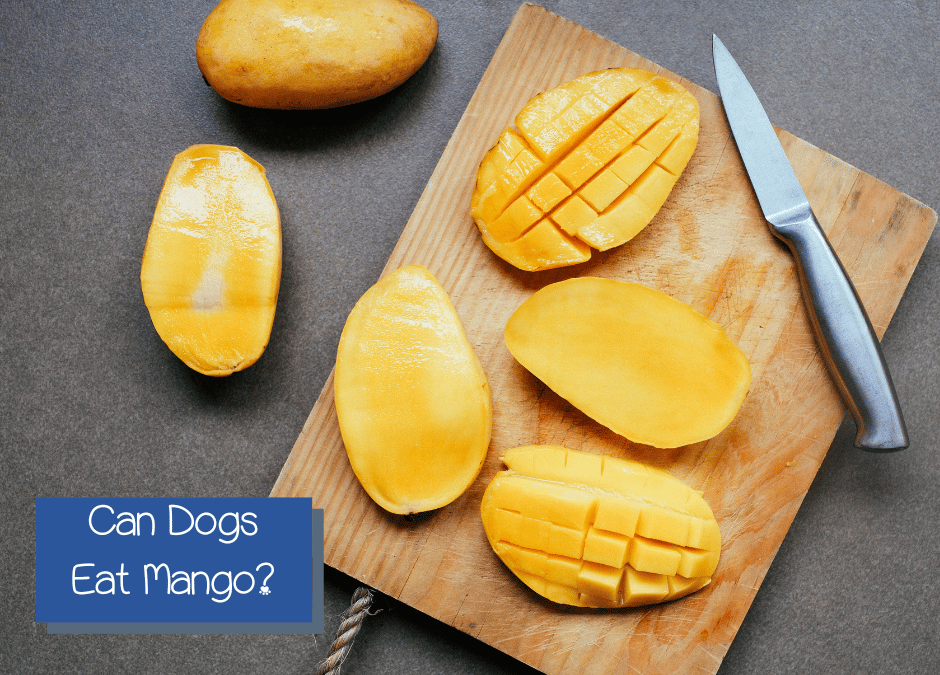Can dogs eat mango? The short answer is yes, dogs can safely enjoy mango in moderation. However, there are a few things to keep in mind before you start adding it to your pup’s diet. Below, we’ll go over everything you need to know! Then, we’ll finish off with an easy-yet-tasty frozen mango dog treat recipe! Let’s jump in, shall we?

Can Dogs Eat Mango? Here’s Everything You Need to Know!
As mentioned above, dogs can absolutely eat mango as long as you’re not overdoing it. My Pharaoh Hound Freya LOVES it! In fact, it’s her second-favorite fruit (watermelon is #1).
The Benefits of Mango for Dogs:
Mangoes are not only a delectable treat for humans but can also offer some potential health benefits for our canine companions. Here are a few advantages of feeding mangoes to dogs:
Nutritional Value: Mangoes are rich in essential vitamins and minerals such as vitamin C, vitamin A, vitamin E, potassium, and dietary fiber. Nutrients like these can help keep your dog’s immune system healthy, support vision, promote good digestion, and aid in maintaining a healthy coat.
Antioxidant Properties: These tasty fruits contain antioxidants like beta-carotene and various phytochemicals that can help combat free radicals, reducing the risk of certain chronic diseases.
Hydration and Digestion: Mangoes are very high in water content, making them great for keeping Fido hydrated, especially during the hot summer months. They also contain digestive enzymes that can assist in breaking down proteins, aiding digestion.
Tips for Safely Feeding Mango to Your Dog:

While mangoes are generally safe for dogs, it’s important to consider the following points:
Moderation is Key: While mangoes offer nutritional benefits, they are also relatively high in natural sugars and calories. Too much mango can lead to digestive upset, such as diarrhea or an upset stomach. Therefore, it’s crucial to feed mango to your dog in moderation as an occasional treat.
Quality and Ripeness: Choose ripe mangoes that aren’t relatively blemish-free (and, obviously, mold-free). Ripe mangoes are softer and easier for dogs to digest. Avoid feeding underripe mangoes as they can be harder to chew and may cause stomach upset.
Remove the Pit and Skin: Before offering mango to your dog, remove the skin, as it can be difficult for dogs to digest and may cause gastrointestinal issues. Then, make sure that you remove the pit since it’s a choking hazard. The pit also contains cyanide (actually, more like substances that break down into cyanide, but same basic concept).
Allergies: While mango allergies are relatively rare in dogs, some canines may be sensitive to certain fruits. Introduce mangoes gradually and monitor your dog for any signs of allergic reactions such as itching, swelling, or gastrointestinal distress. If you suspect an allergic reaction, discontinue feeding mangoes and consult your veterinarian.
Variety and Balanced Diet: Remember that mangoes should not replace your dog’s regular balanced diet. They should be viewed as an occasional treat or addition to their meals. Consult with your veterinarian to determine the appropriate amount of mango to include based on your dog’s specific dietary needs.
Regarding the first point about moderation, too much mango really can upset your dog’s stomach. I learned this the hard way. I’ll spare you the super gross details, but it’s definitely a “lesson learned” sort of thing! Also, while most dogs can safely eat mangoes, it’s high in sugar. So it’s probably best not to give it to diabetic dogs. Talk to your vet about that, though.
If you’re wondering how to cut a mango (I had a REALLY hard time figuring out how to cut them since the seed/pit is so ginormous), check out the video below. The first two methods were the easiest for me.
Easy Frozen Mango Dog Treat Recipe
On a hot day, you can offer your dog a refreshing frozen mango treat. Just blend ripe mangoes and freeze the puree in ice cube trays. If you want something a little fancier (for lack of a better word), though, here’s a super quick and easy recipe.

(Full disclosure, the photo above is from our Frozen Pumpkin Banana Pops, but the mango treat looks pretty much the same. I just didn’t have a chance to take photos of it yet).
Ingredients:
2 ripe mangoes
1/2 cup plain Greek yogurt
1/4 cup water

Instructions:
Peel the mangoes and remove the pits. Cut the fruit into small pieces.
Place the mango pieces into a blender or food processor. Add the plain Greek yogurt and water.
Blend until smooth. If the mixture is too thick, you can add a little more water. Just add a smidge at a time!
Pour the mango puree into ice cube trays or silicone molds.
Freeze for at least 2-3 hours, or until solid.
Once the treats are frozen, remove them from the molds. If using ice cube trays, you can pop them out by twisting the tray or running warm water on the bottom briefly to loosen the treats.
Store in an airtight container or freezer bag in the freezer until you’re ready to serve them to your dog.
Building on my point above about learning the hard way that too much of a good thing is a REALLY bad thing with Freya, I recommend that you give your dog just one or two “cubes” at a time. While all dogs are different, that seems to be the “just right” serving for my girl.
Oh, by the way, you can even customize this recipe by adding other dog-friendly ingredients, like peanut butter or berries! You can also incorporate mango into our Very Berry Frozen Dog Treat or our Peanut Butter Banana Pup-Pops!

In conclusion, dogs can safely eat mangoes as long as they are given in moderation and prepared safely. Mangoes are loaded with nutritional benefits, antioxidants, and hydration for your canine pal. However, make sure to remove the pit and skin, feed in moderation (I cannot stress that enough), and be aware of any potential allergies or sensitivities your dog may have.
Does your dog like mango? Share your thoughts below! Oh, and do you spell it “mangos” or “mangoes?” Inquiring minds want to know!


